Contents
Ajay Heble
Alternative Models of Community and Social Cooperation: Festivals, Pedagogy, Social Practice
Saturday, January 22, 2022 from 3:30 PM – 4:00 PM
In this talk, I’d like to consider festivals as resonant, if largely underacknowledged, sites for advancing social justice through the arts. I’m interested in how best, as arts presenters, we can build the curatorial capacities of arts organizations so that they might participate meaningfully in enabling generative forms of community-making, critical thinking, and social practice. What might it mean to consider festival organizers as community-based educators and activists? To understand festivals as alternative pedagogical institutions? To recognize the work we do at our festivals as a vital form of activist arts-based practice? I’ll argue that festivals are not simply about programming; rather, they are complex sites for practicing the social, for activating diverse energies of critique and inspiration, for making a difference in their communities by creating time and space to sound, and to stage, new forms of social organization. They are public-facing pedagogical interventions that frequently question static relations of power, that seek to build alternative models of community and social cooperation, and that often explicitly set out to challenge taken-for-granted representations. Curatorial decisions, in other words, are far from neutral: they involve choices that are connected in complex and important ways to broader struggles over resources, identity formation, and power.
My work on (and my vision of) festivals takes its primary cue and inspiration from creative and critical practices that seek to define broader pedagogical priorities in terms of an activist and community-based orientation. Critic and educator Doris Sommer suggests in her book The Work of Art in the World that what may begin as an artistic practice doesn’t necessarily stop there. It can, as she puts it, “ripple into extraartistic institutions and practices. Humanistic interpretation,” she continues, “has an opportunity to trace those ripple effects and to speculate about the dynamics in order to encourage more movement.” Celebrating a growing interest in community-engaged pedagogy, Sommer tells us that “[i]n the best cases, engagement combines with public scholarship to identify underrepresented creative partners who test, stretch, and refine what we learn and teach.” Building on such outward-looking prompts—and inspired by Sommer’s call for an engaged pedagogy that can test, stretch, and refine our teaching and learning practices—I will use this talk on festivals to prompt consideration of how alternative pedagogical institutions function in our communities, and with what impact.
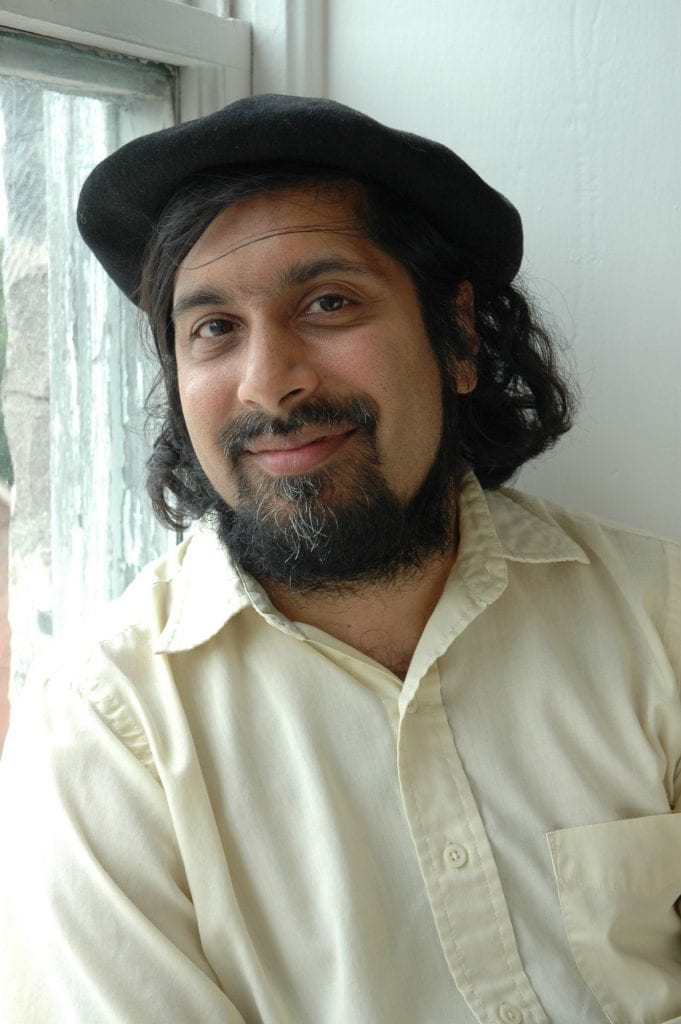
Dr. Ajay Heble is the founding Director of the International Institute for Critical Studies in Improvisation (IICSI), and Professor of English in the School of English and Theatre Studies at the University of Guelph. His research has covered a full range of topics in the arts and humanities and has resulted in 15 books published or in press, numerous articles or chapters, and over 100 graduate students and post-doctoral fellows trained and mentored. He was the founding Artistic Director of the award-winning Guelph Jazz Festival and Colloquium (he served in that capacity for 23 years, retiring in 2016), and is a founding co-editor of the peer-reviewed journal Critical Studies in Improvisation/Études critiques en improvisation (www.criticalimprov.com). Dr. Heble is the recipient of numerous awards, including the 2016 SSHRC Impact Award in the Partnership category.
Heble is also an accomplished pianist with a long background as a performer. His first CD, a live set of improvised music called Different Windows with percussionist Jesse Stewart, was released on the IntrepidEar label in 2001. His recent recordings include Hold True (Accroche-Toi), The Time of the Sign, and Le gouffre / The Chasm, all with his improvising quartet The Vertical Squirrels (and released on the Ambiances Magnétiques label).
Image description: A man in a black beret smiles at the camera, posed next to a window.
Allyson Mitchell and Deirdre Logue
Build Spaces Embody Them
Friday, January 21, 2022 from 11:30 AM – 12:00 PM
Collaborators Allyson Mitchell and Deirdre Logue will share their experiences of embodied practices through large and micro scale queer feminist world/space building that include a lesbian haunted houses, feminist art gallery and most recently an artist residency program that mutually benefits artists, activists, land, trees, creatures and decomposers. Together they will present what they have learned and are in the process of learning about difference and identity, feminist pasts, presents and futures, intersectionality, crip, queer and fat culture, access, activism and beyond.
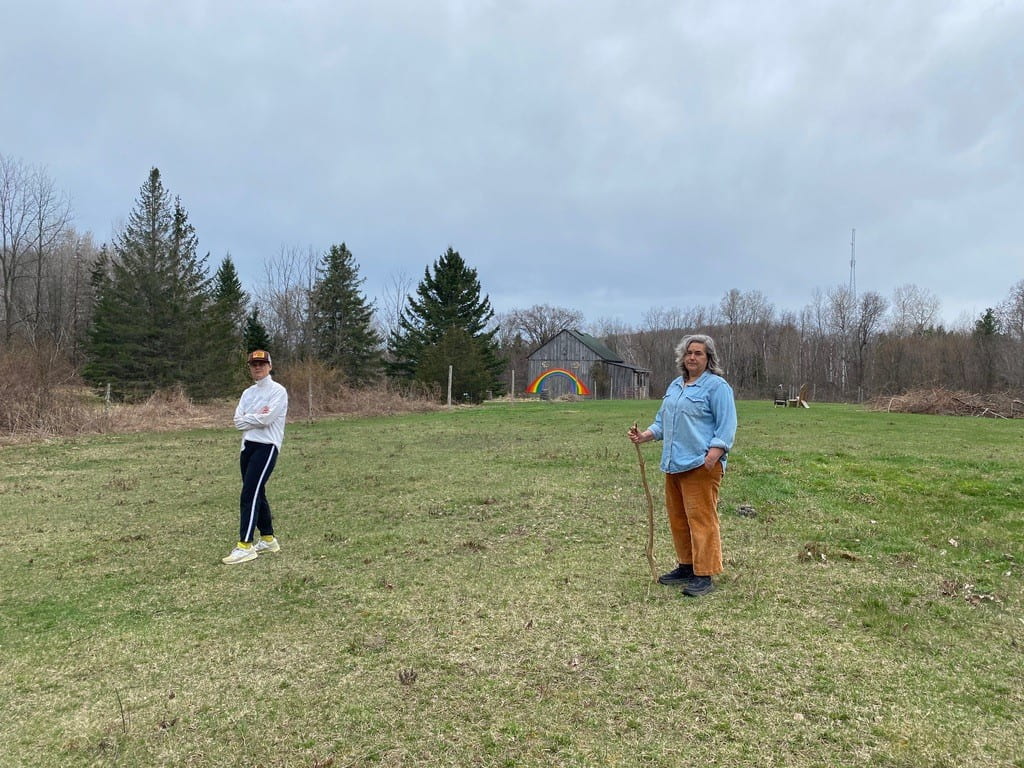
Deirdre Logue and Allyson Mitchell share a collaborative maximalist art and life practice that includes art production, exhibition and activism. Since 2010 they have operated the F.A.G Feminist Art Gallery in Toronto Canada. Since 2020 they have been developing and initiating a land based artist residency called F.A.R – a moveable acronym that that could stand for Feminist Art Residency, Fatties are Rad, Fuck All Regiemes, Feed Activists Regularly……
Recently Logue and Mitchell presented Killjoy’s Kastle: A Lesbian Feminist Haunted House. This epic installation/performance is a nightmarish vision of feminist terror where visitors are encouraged to dialogue about contemporary queer politics. They also collaborate on video installations that put radical feminist texts in conversation with contemporary queer theory using puppets, cats and paper mache tactics. Mitchell works as an Associate Professor in the School of Gender, Sexuality and Women’s Studies at York University and Logue is currently the Development Director at Vtape.
Image description: Two people stand about 3 metres apart on an open grassy field with a line of trees behind and a grey barn with a rainbow painted on its front. One person is wearing a blue shirt and brown pants. They have long grey hair and are holding a stick. The other person is wearing a white top and black pants with a white stripe down the leg. They are wearing a hat and white shoes.
Arseli Dokumaci
Activist Affordances: How Do Disabled People Improvise Survival Within Shrinkage?
Saturday, January 22, 2022 from 10:15 AM – 11:00 AM
How do you lift a glass of water to your mouth when your fingers and shoulders are impaired and inflamed? How do you put on your clothes or take them off, when your entire body is in pain? What do you do to cross streets when traffic ‘lights’ are not adapted to your needs as a blind pedestrian? In this talk, I argue that it takes an immense amount of ingenuity, labour and artfulness to get these seemingly simple daily tasks done, when the body/mind in question is sick, impaired, in pain, debilitated, mad or otherwise disabled. Drawing on two visual ethnographic projects conducted in Turkey and Quebec, as well as autoethnographic materials, I demonstrate how disabled people imagine and bring into being more habitable worlds in the most fleeting of movements and the most ordinary of everyday actions that I call “activist affordances”.
If affordances refer to possibilities for action emerging from body-environment mutuality (Gibson 1979), I propose that we can think of disability as “shrinking” of the environment and so too of its existing affordances. Shrinkage might be evident for a person in a wheelchair facing a flight of stairs. But shrinkage happens in other less evident situations or at scales invisible to human perception. It may be that a diabetic person can no longer benefit from the affordances of certain type of food. It may be that a person is in such pain or so depressed that she is not able to get out of bed. It may be that a pandemic hits and populations have to “quarantine” and go into “lock-downs” for months. While the causes of shrinkage vary, the space for action shrinks and the environment affords fewer possibilities of action regardless of cause, and I introduce the concept of “shrinkage” to name precisely this common ground and foster coalitions between disability and variegated states of living that may or may not be recognized as disability.
Shrinkage as constraint provides the ground for the theory of activist affordances. Because, as I will demonstrate by making analogies between the creative space of aesthetic performance and the performance of everyday life lived with disability, it is precisely under conditions of shrinkage, that “something else” of activist affordances happens. When the environment narrows down in its offerings, and when its materiality turns into a set of constraints rather than opportunities, the space of performance opens up and allows us to “make” that same environment afford otherwise. Drawing on my participants’ videotaped descriptions, I demonstrate how disabled people may dance the affordances of accessible worlds in their physical absence, and live disabled lives as “good” lives within a shrinking world of possibilities.

Arseli Dokumaci (she/her) is the director of the Access in the Making Lab and Canada Research Chair in Critical Disability Studies and Media Technologies. Arseli is an interdisciplinary scholar and creative practitioner. Her scholarly and creative work lies at the crossovers of disability studies, performance studies, and medical anthropology. In her research, and research-creation videos, Arseli explores how disabled people go about their everyday lives, and come up with micro, improvisational solutions that she theorizes as activist affordances. Arseli is particularly interested in exploring how disability can be a critical a method to rethink and practice media in new ways.
Her research has appeared in Current Anthropology, The South Atlantic Quarterly, Disability Studies Quarterly, Performance Research, and in other journals and edited collections. Arseli is currently finishing her first manuscript, Activist Affordances: Disability, Ecology and Performance (under contract with Duke University Press) and launching a four-year SSHRC-funded interdisciplinary team project, entitled “Mobilizing disability survival skills for the urgencies of the Anthropocene” (PI. Dr. Dokumaci).
Image description: An olive-skinned woman with dark short hair and glasses, wearing a white patterned shirt, red lipstick and smiling against a dark turquoise background.
Carmen Papalia
Open Access: Setting a New Cultural Standard for Accessibility
Saturday, January 22, 2022 from 1:30 PM – 2:15 PM
Carmen Papalia will present on his 2021 exhibitions Provisional Structures, Carmen Papalia with Vo Vo & jes sachse (curated by Nicolle Nugent, MacKenzie Art Gallery), and Fireflower, Carmen Papalia with Collin van Uchelen (curated by Whitney Mashburn, Grunt Gallery), two projects that set a new cultural standard for accessibility by nurturing creative and justice-oriented accessibility practices.
Both exhibitions are the result of long-term processes that were informed by Papalia’s 2015 Open Access manifesto, an accessibility framework that moves beyond compliance-level accessibility measures with guidelines for mutual care. Consisting of 5 tenets that describe what it means to organize support in the midst of an oppressive system, Open Access mobilizes an interrogation of the conditions that restrain agency and decision-making power over strengthening accessibility measures that are the result of legal and regulatory compliance. When put into practice, it problematizes the conventions of the accommodation paradigm for accessibility by encouraging participants to collectively envision a space that suits their needs, then share accountability towards that vision as they organize accessibility together.
Related link:

Carmen Papalia is a nonvisual social practice artist with severe chronic and episodic pain. In 2021 he co-founded the Open Access Foundation for Arts & Culture (OAFAC), a pandemic-era cultural organization that aims to set a new cultural standard for accessibility by nurturing creative and justice-oriented accessibility practices. Addressing the limited representation of those with lived experience of disability in leadership roles within the visual and performing arts, OAFAC’s activities advance disability culture and artistry within a contemporary art context through disability-lead trainings, curation, public engagements, exhibitions, performances, educational campaigns and site-specific project development with artists, curators and cultural workers.
Since 2009, Papalia has used organizing strategies and improvisation to address his access to public space, the art institution and visual culture. As a convener, he establishes welcoming spaces where disabled, sick and chronically ill people build capacity for care that they lack on account of governmental failure and medical ableism. His work, which takes forms ranging from collaborative performance to public intervention, is a response to the harms of the Medical Model of Disability, a framework that erases disability experience by reinforcing ableist concepts of normalcy. In 2020, Papalia was one of 25 artists who received the Sobey Art Award; in 2019 he was a Sobey long list recipient in the West Coast / Yukon region. Papalia also received the 2014 Adam Reynolds Memorial Bursary, which supported a 3-month residency at the Victoria & Albert Museum in London, and the 2013 Wynn Newhouse Award. His work has been featured at The Museum of Modern Art, the Solomon R. Guggenheim museum, the Tate Liverpool, the Whitney Museum of American Art, the Banff Centre for Arts and Creativity and Gallery Gachet, among others.
Image description: Against a blurry background of rocks and ocean, a close-up of the artist Carmen Papalia, an olive-skinned man with brown eyes, a dark, close-trimmed beard, and a gray hat.
Karen Yoshida, Fady Shanouda, Jeff Thomas, Sean Lee, and nancy viva davis halifax
Developing Oral History Interview Processes that Reflect Embodied Differences and Social Justice
Friday, January 21, 2022 from 4:00 PM – 4:45 PM
In this paper, we document our experiences of developing processes to conduct oral history interviews with first generation disabled artists in Ontario. Mia Mingus’s view of access intimacy as shared work between disabled and non-disabled people is an important starting point. We were committed to engaging with artists during this process focusing on access in its many forms, supporting each other, and being respectful of embodied differences. Mingus (2017) notes that abled –bodied people need to inhabit our world. Given these important starting points, these interviews involved work on our part that is often not part of oral histories projects, but is work that is grounded in a social justice framework.
Disruptions embraced (3 versions):
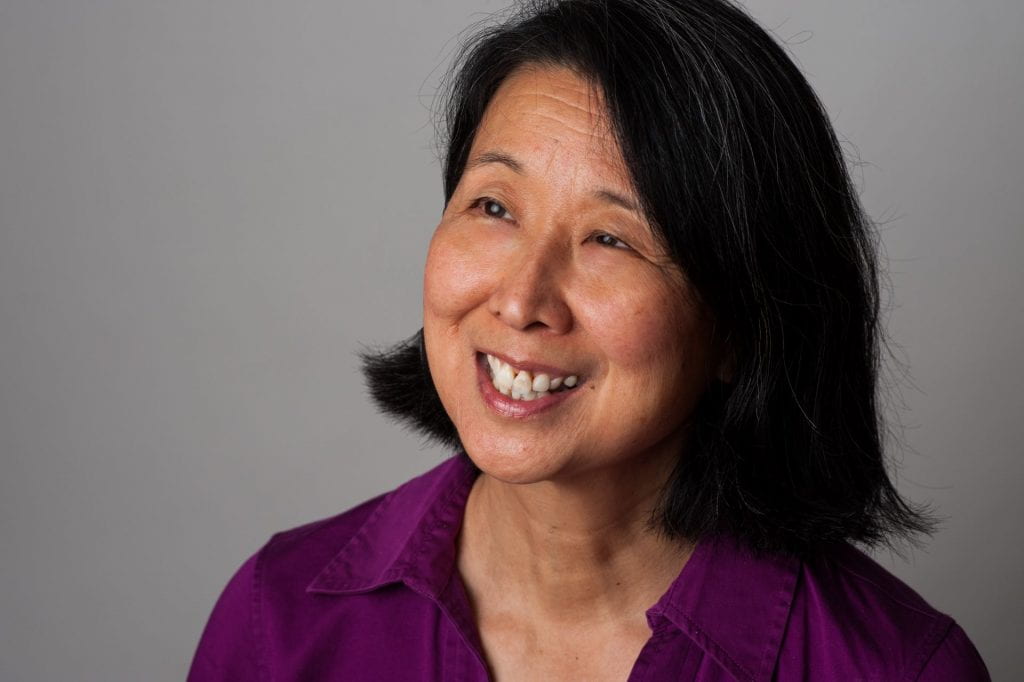
Karen Yoshida, Ph.D. is Professor, Department of Physical Therapy and cross-appointed to the Dalla Lana School of Public Health- Social Science Division and a collaborating member for the Centre for Research in Women’s Health. Since 1987, she leads an innovative Critical Disability Studies and diversity component, in partnership with the disability rights communities in Toronto within the MSc. Physical Therapy program. Her research interests focuses on Activist Disability Oral History, arts-based research and dissemination, and community disability leadership and activism among disabled young adults. Presently, Dr. Yoshida is a co-investigator on the Bodies in Translation: Activist Art Technology and Access to Life. SSHRC partnership grant. In this grant, Dr. Yoshida is leading an oral history study on Canadian disabled artists and cultural activists.
Image description: Karen is smiling looking upwards to the left. She has black hair almost to her shoulder and dark brown eyes. She is wearing a burgundy collared shirt.

Fady Shanouda (he/him) is an Assistant Professor at the Pauline Jewett Institute of Women’s and Gender Studies at Carleton University. He is a Critical Disability Studies scholar whose research examines disabled and mad students’ experiences in higher education. His scholarly contributions lie at the theoretical and pedagogical intersections of Disability, Mad, and Fat Studies and include socio-historical examinations that surface the interconnections of colonialism, racism, ableism/sanism and fatphobia. He has published scholarly articles on disability/mad-related issues in higher education, Canadian disability history, the anti-fat bias in medicine, and community-based learning.
Image description: Fady, an olive-skinned fat man with shoulder length brown curly hair, is wearing a blue shirt. A purple lilac tree is visible in the blurred background.

Jeff Thomas (b. 1956, Buffalo, New York) is an urban-based Iroquois, self-taught photo-based story teller, writer, pubic speaker, and curator, living in Ottawa, Ontario, and has works in major collections in Canada, the United States, and Europe. Jeff’s most recent solo shows were Birdman Rising, University of Southern Illinois, A Necessary Fiction: My Conversation with Edward S. Curtis & George Hunter, Art Gallery of Mississauga, The Dancing Grounds, Wanuskewin Heritage Park (Saskatoon), and Resistance Is NOT Futile, Stephen Bulger Gallery (Toronto). Thomas has also been in many group shows, including The Family Camera, Royal Ontario Museum, Toronto, Ontario, Tributes + Tributaries, 1971-1989, Art Gallery of Ontario, Land/Slide: Possible Futures, Markham, Ontario, SAKAHÀN, National Gallery of Canada, UNMASKING: Arthur Renwick, Adrian Stimson, Jeff Thomas, Canadian Cultural Centre, Paris, France. In 1998, he was awarded the Canada Council’s Duke and Duchess of York Award in Photography, Royal Canadian Academy of Art (2008), The Karsh Award in photography (2008), the REVAL Indigenous Art Award (2017), and the Canada Council Governor General Award in the Visual and Digital Arts (2019).
Image description: I am First Nations. In my selfie portrait you see my head and shoulders. I have very long hair that is greying, I am a large man, wearing a blue tee-shirt, I have a pleasant look on my face. I am 65 years old and I am also wearing black rim glasses.

Sean Lee is an artist and curator exploring the assertion of disability art as the last avant-garde. His methodology explores crip curatorial practices as a means to resist traditional aesthetic idealities. Orienting towards a “crip horizon”, Sean’s practice explores the transformative possibilities of accessibility as an embodied politic and disability community building as a way to desire the ways disability can disrupt. In addition to his position at Tangled Art + Disability, Sean is an independent lecturer, speaker, and writer adding his insights and perspectives to conversations surrounding Disability Arts across Canada, the United States and internationally. Sean currently sits on the board of CARFAC Ontario, Creative Users Projects, and is a member of the Ontario Art Council’s Deaf and Disability Advisory Group and Toronto Art Council’s Visual Arts / Media Arts Committee.
Photo credit: Courtesy of Michelle Peek, Bodies in Translation, Cripping the Arts Symposium (2019)
Image description: Sean Lee, an East-Asian, male-presenting person smiles at the camera. He wears steampunk glasses that are green with gold frames, and has cropped hair with blunt bangs. He wears a beige shirt-dress that is animated by spots of fringed sleeping animal drawings.

nancy viva davis halifax was born on the north shore of new brunswick on mi’gma’gi territory \ i am a white settler \ queer & crip \ a celtic mongrel \ working on stolen & sacred lands \ heir to a complex history & present of dispossession & resurgence \ i was trained as a conceptual artist at the Nova Scotia College of Art & Design \ a training that continues to influence my art praxis \ as activist & embodied \ of the body & responsive to wounds written on body\s
Image description: A black & white close up of nancy halifax with her service dog Stan. They are lying down together in a beam of sunlight.
Kim Tallbear and Simon(e) van Saarloos
A Non-monogamous Exchange
Thursday, January 20, 2022 from 6:30 PM – 7:30 PM
A few months into the Covid-19 pandemic, Kim TallBear and Simon(e) van Saarloos started a very slow building letter exchange between Edmonton (Canada) and Amsterdam (the Netherlands) to discuss non-monogamy in a (not so new) time of state ordered isolation and shelter in place. In this keynote, TallBear and Van Saarloos invite you in on their letter exchange. How do settler colonial notions of time, individualized safety, ableist assumptions and relationship to land and non-human existence inform our intimate lives?
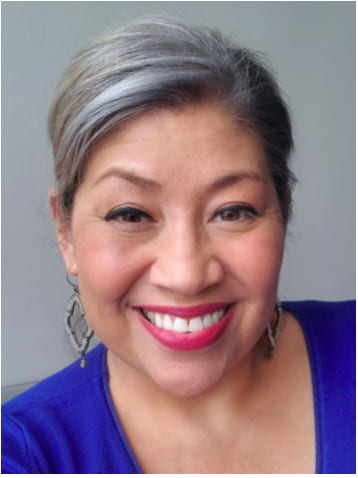
Kim TallBear (Sisseton-Wahpeton Oyate) (she/her) is Professor and Canada Research Chair in Indigenous Peoples, Technoscience and Environment, Faculty of Native Studies, University of Alberta. She is the author of Native American DNA: Tribal Belonging and the False Promise of Genetic Science. In addition to studying the genome sciences disruptions to Indigenous self-definitions, Dr. TallBear studies colonial disruptions to Indigenous sexual relations. She is a regular panelist on the weekly podcast, Media Indigena. You can follow her research group at https://indigenoussts.com/. She tweets @KimTallBear.
Image description: Kim looks straight into the camera with a bright smile. Her eyes are twinkling and her hair is dark with streaks of silver-gray. She is wearing earrings and a blue top.

Simon(e) van Saarloos is a writer and artist. They published several books, among which Playing Monogamy. Their most recent book is a non-fiction work about queer forgetfulness, whiteness and embodied commemoration. Together with collaborator Kübra Uzun, Simon(e) created an audio installation titled Cruising Gezi Park (Amsterdam Museum), initiated a conference with a catwalk (“The Architecture of Sex”) and organizes “Through The Window”, an online queer art solidarity project between Turkey and the Netherlands. Simon(e) is the curator of the 2021 exhibition on Abundance (‘We must bring about the end of the world as we know it’ – Denise Ferreira da Silva) in Het HEM. They are also the host of *The Asterisk Conversations podcast and recently started a PhD in the Rhetoric department at UC Berkeley. Visit Simon(e)’s website and follow her @svansaarloos.
Image description: Simon(e) is standing upright and looks very serious, with frowning brows. They are a white person with blond short hair. They are wearing a black turtleneck and a colorful sweater with a bright print of lips, noses and eyes.
May Friedman, Sonia Meerai, E. Adjei-Manu, Casandra Fullwood, Claudia Jones, Ashana Persaud, and Verlia Stephens
“Our Bodies are More Than Our Bodies”: Exploring Weight Stigma and Race
Saturday, January 22, 2022 from 4:00 PM – 5:15 PM
Fat Studies has come into its own as a field in the last 10-15 years. The study of weight stigma and the specific implications for fat bodies has gained increasing traction in a range of interdisciplinary settings. While the field has deeply intersectional investments in identity related scholarship such as critical disability studies and queer and trans literatures, Fat Studies has been rightly accused of a lack of attention to the specific implications of race. Though contemporary research aims to address this limitation (Friedman, Rice, and Rinaldi, 2020; Strings, 2019, among others), there is still a surprising lack of attention to the specificities of how fat phobia is displayed among BIPOC communities, particularly as these communities live within other complicated intersections and experiences. Our research has addressed this gap.
Through immersive first-person storytelling in the form of digital stories, nine brilliantly created digital stories which illustrate the complexities, tenderness, and power at the intersections of weight and race were created. Our presentation will provide an overview of the digital storytelling process via a virtual format during the COVID-19 pandemic, unpack the complicating and intricate themes that weave our stories together, share a 27-minute screening of our stories, and provide the audience to participate in a Q and A session with the storytellers. Our stories embody and assert that “our bodies are more than our bodies.”
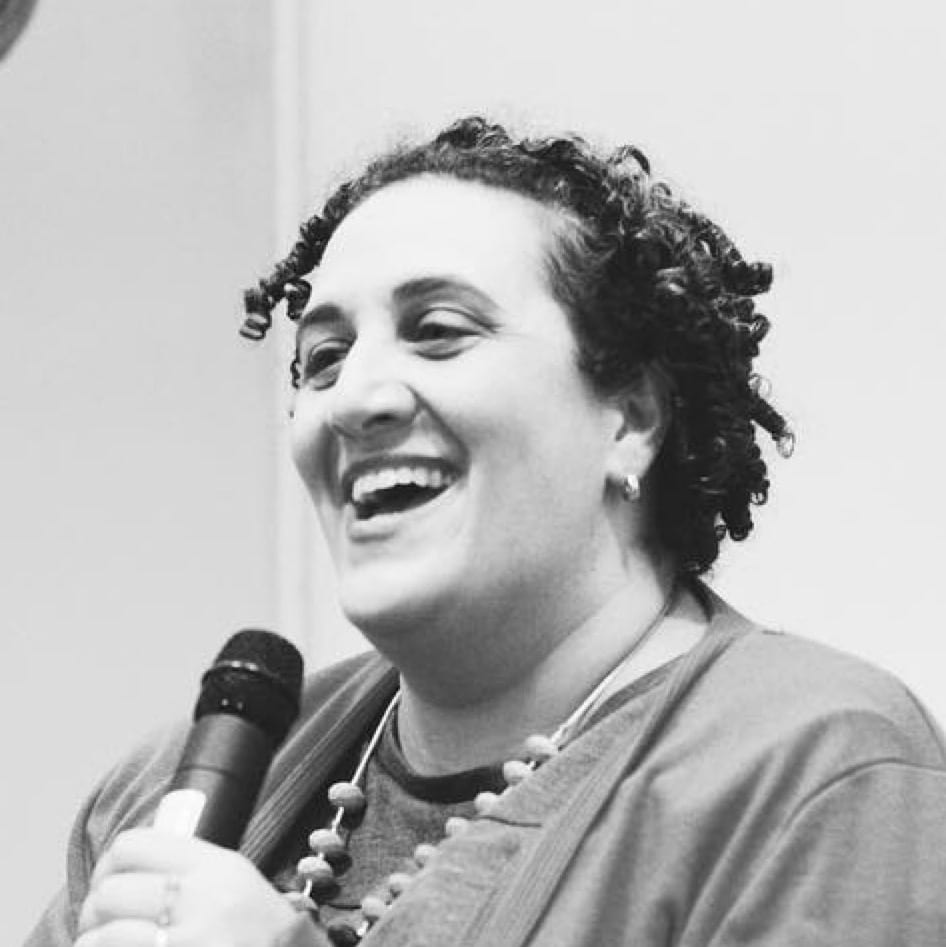
May Friedman’s (she/her) research looks at unstable identities, including bodies that do not conform to traditional racial and national or aesthetic lines. Most recently much of May’s research has focused on intersectional approaches to fat studies considering the multiple and fluid experiences of both fat oppression and fat activism.
Image description: A black and white photo of May, a brown woman. She is wearing a soft cardigan, chunky necklace, earrings, and has short black curly hair. She is smiling widely while speaking into a microphone.

Sonia Meerai is a Ph.D. student in the Gender, Feminist and Women Studies at the Faculty of Graduate Studies, York University. Her main research areas include critical feminist approaches to understanding health technology, tracking applications, and at-home health management technologies at the intersections of gender, fatphobia/weight stigma, race/racism, surveillance, and bio-capitalism. Issues undertaken at these intersections include: (in)fertility, cardiovascular health, and chronic conditions (i.e., COPD, heart failure, diabetes).
Image description: Sonia is looking directly ahead, with the image cut off at her shoulders. Her skin is medium brown (she is woman-identified, indo-Guyanese), black hair which is tied back to towards the right side. Her eyes are dark brown, and is wearing a fuchsia coloured lipstick, she is smiling with her upper teeth showing more than her bottom teeth. Her right ear is showing with a small white coloured stud earring. The collar of her top has white and blue stripes, and the overlay of her dress is dark navy. There is a black mole on her upper right cheek
Melisa Cahnmann-Taylor
Theatre for Agency, Activism, and Acting Up with Language in TESOL Teacher Education
Saturday, January 22, 2022 from 12:00 PM – 12:30 PM
Reflecting on English language learner (ELL) students’ struggles with prejudice and privilege, Dr. Cahnmann-Taylor discusses how Acting up with Language activities can help all language learners prepare to engage in social justice work focused on classroom equity, community equity and global equity. Examples of theatre from Latin America and the U.S. civil rights movement illustrate the ways theatre can help teachers validate and navigate language learners’ personal and social struggles through language, but also prioritize students’ triumphs and assets. Sharing games from her new book, Enlivening Instruction with Drama and Improv: A Guide for Second Language and World Language Educators (Routledge, 2021), Cahnmann-Taylor will share examples of theatre structures that can extend classroom dialogue into public performance forums and opportunities for social change.
Related links:
Find links to Melisa’s articles, books and poetry about teaching and learning second languages and living in multicultural & multilingual community on her website as well as the following academic sites:
- ORCID: https://orcid.org/0000-0001-5667-8695
- RESEARCH GATE: https://www.researchgate.net/profile/Melisa_Cahnmann
- Melisa Cahnmann-Taylor website

Melisa “Misha” Cahnmann-Taylor, Professor of Language and Literacy Education at the University of Georgia, is co-author of four scholarly books in education: Teachers Act Up: Creating Multicultural Learning Communities Through Theatre (2010); two editions of Arts-Based Research in Education (2008; second edition, 2018) and Enlivening the Language Classroom with Drama and Improv. A poet, she is also the author of a book of poems, Imperfect Tense, (2016), and currently serves as a Fulbright Ambassador Alum speaking about the power of poetry and theatre in teaching second or additional languages. Winner of four “Big Read” Grants from the National Endowment for the Arts, the Beckman award for “Professors Who Inspire Social Change,” Dorothy Sargent Rosenberg and Anna Davidson poetry prizes, and a Fulbright for nine-month study of adult Spanish language acquisition in Oaxaca Mexico, she is a regular international speaker whose recent engagements include a 2017 Richard Ruiz Fellowship in Guanajuato, Mexico and an invited plenary to the 2018 English Teachers Association of Israel. A graduate of the New England College low-residency MFA program and the University of Pennsylvania’s Educational Linguistics doctoral program, her poems, essays, and articles about language learning have appeared in numerous literary and scholarly journals can be found on her website. She lives in Athens, GA with her husband and two children and their rescue dog, Bagel.
Image description: Melisa smiles facing the camera. A white woman with shoulder length brown hair, she stands against a brick wall with her left hand in her pocket.
Mona Stonefish
Welcome & Opening to Practicing the Social
Friday, January 21, 2022 from 8:45 AM – 9:30 AM

Mona Stonefish (Bear Clan) is an Anishinaabe Onkwehón:we Elder, Doctor of Traditional Medicine, international activist, Senator of the Anishinaabemowin Teg – language preservation, a Keeper of Wisdom, and a Grandmother Water Walker. Mona Stonefish is also a member of the Native American Museum of Washington D.C., a traditional dancer, and recipient of the Queen Elizabeth II Diamond Jubilee Medal (2013). She and her granddaughter Sky Stonefish support and teach one another, confront discrimination, and fight to tear down barriers in their travels together.
Image description: Mona Stonefish speaks into a microphone. Mona is an Onkwehón:we Elder with long silver and black braids. She wears thin-rimmed glasses, dangling earrings, and a black top with turquoise accents.
Syrus Marcus Ware
Black Crip Justice: Building Towards an Accessible Abolitionist Future Through Creative Practice and Praxis
Friday, January 21, 2022 from 9:30 AM – 10:15 AM
I will be exploring Black liberators’ struggles and their links to disability justice. I will explore Black crip methodologies for creation and will showcase some new works. Thinking about irresistible revolutions and future systems change, I will consider what is needed for a thriving Black crip future.

Syrus Marcus Ware is an Assistant Professor at the School of the Arts, McMaster. He holds a PhD from York University in the Faculty of Environmental Studies. Syrus is a Vanier scholar, visual artist, activist, curator and educator. Syrus uses drawing, installation and performance to explore social justice frameworks and black activist culture, and he’s shown widely in galleries and festivals across Canada. He is a co-founder of Black Lives Matter- Canada, a core-team member of Black Lives Matter – Toronto, and a part of the Performance Disability Art Collective. His on-going curatorial work includes That’s So Gay (Gladstone Hotel, 2016-2019) and BlacknessYes!/Blockorama (2003-present).
Image description: syrus looks at the camera, smiling. He is a Black trans man and he is wearing a bright African print textile jacket and bright Blue lipstick and purple eyeshadow. He has a short beard. He is standing in front of a bookshelf in the sun.
Taqralik Partridge, Jocelyn Piirainen, Anna Hudson, Laakkuluk Williamson Bathory, Koomuatuk Sapa Curley, Georgiana Uhlyarik
This Conversation Attempts to Reveal This Magic from the Perspective of Its Seven Key Actors
Saturday, January 22, 2022 from 9:00 AM – 10:00 AM
Everybody sit down!: The Seal Feast – The moment the thawing harp seal reached Walker Court on June 13th, 2018 for the public opening of Tunirrusiangit: Kenojuak Ashevak and Tim Pitsiulak at the Art Gallery of Ontario, the air became electric. An inexplicable combination of excitement and trepidation gripped the crowd who edged in closer. “Sit down,” instructed Anishinaabekwe artist, Rebecca Belmore. “Everybody sit down,” echoed Laakkuluk Williamson Bathory, a Kalaallit artist and performer and one of the curators of the exhibition. The crowd sat. Inuit and First Nations guests looked on in joy and reverence. Others were fixed with wonder. Within minutes Laakkuluk, along with Inuk artists Ruben Komangapik and Koomuatuk Curley (another member of the curatorial team) had removed the skin and flippers to reveal the deep red flesh of the seal meat. Working quickly, sushi boats filled with ulu-cut morsels circulated through the space. Inuit elders welcomed cultural sustenance and others remarked how good it tasted. We all ate Inuit country food – a seal hunted by Kenojuak’s own grandson in Kinngait and shipped, frozen solid, to downtown Toronto. Anticipation of the event, knowing that such a feast had never been staged at a major public art institution, was anxious. Hoops jumped, gatekeepers quelled, Public Health assured, and seal caught added up to something magical. This conversation attempts to reveal this magic from the perspective of its seven key actors.
This video footage documents the Seal Feast held at the Art Gallery of Ontario for the opening of Tunirrusiangit: Kenojuak Ashevak and Tim Pitsiulak on June 13th, 2018. It shows the frozen seal, caught in the community of Kinngait, being brought into Walker Court where Kuzy Curley, Ruben Komangapik and Laakkuluk Williamson Bathory carve it up to serve to the public. The video soundtrack is by Nelson Tagoona.
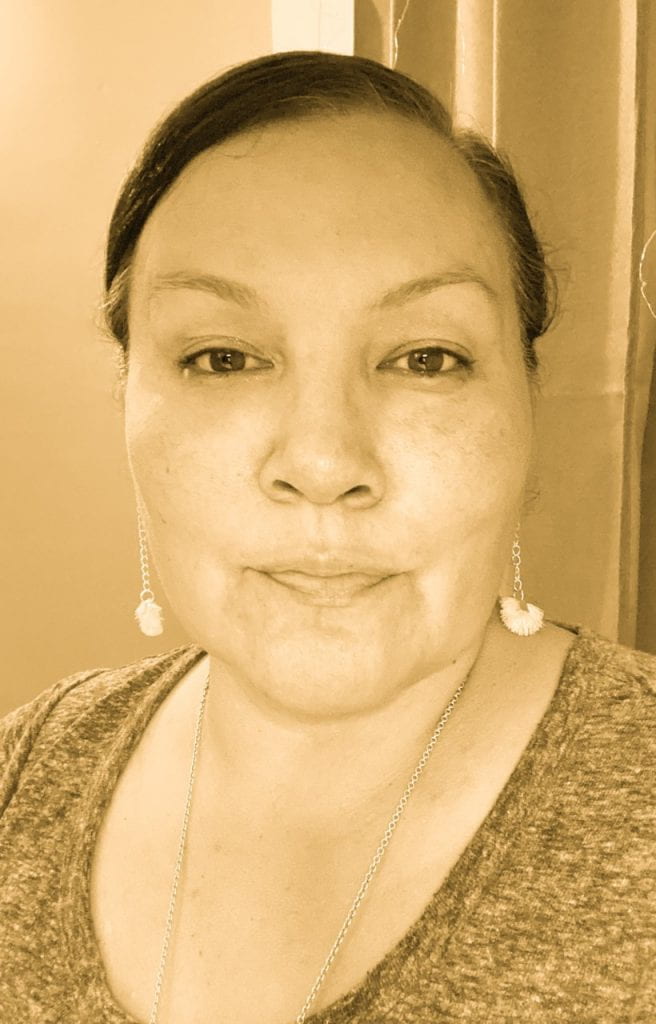
Taqralik Partridge is a writer, artist and curator originally from Nunavik and now based in Ottawa. She has exhibited her work as part of the Biennale of Sydney and Among All These Tundras, and curated Qautamaat | Every day / everyday, an exhibition featuring Inuit photography at the Art Gallery of Guelph. A former Editor-at-Large for the Inuit Art Quarterly, Partridge has also recently released a book of poetry, Curved Against the Hull of a Peterhead (2020). She is the Director of the Nordic Lab at SAW, Ottawa, and adjunct curator at the Art Gallery of Guelph.
Image description: In this sepia-tone photo, Taqralik gazes at the camera with a serious expression and her dark hair is pulled back. She wears long earrings and a scoop-neck shirt.

Jocelyn Piirainen is an urban Inuk, originally from Iqaluktuuttiaq (Cambridge Bay), NU, and since 2019, has been working as the Assistant Curator of Inuit Art at the Winnipeg Art Gallery-Qaumajuq. A graduate from Carleton University, her educational background has primarily focused on the arts, particularly film and new media. When not working as a curator, her artistic practice primarily involves analog photography and film — mostly experimenting with Polaroids and Super 8 film — as well as honing her crochet and beading skills. She has contributed to publications such as Canadian Art, Canadian Geographic and the Inuit Art Quarterly.
Image description: Jocelyn rests her arm on a curved white wall with various gallery objects and pictures behind her. She has short dark hair, glasses, a black shirt, a scarf around her neck, and she is smiling.

Anna Hudson, PhD / FRSC, is an art historian and curator specializing in 19th and 20th-century art in Canada, in addition to modern and contemporary circumpolar Indigenous art and performance. Hudson is a professor of Art History and Visual Culture in the School of the Arts, Media, Performance & Design at York University (Toronto). She also continues to research and publish in the area of her doctoral dissertation, Art and Social Progress: the Toronto community of Painters (1933–1950), exploring the influence of scientific humanism on art, criticism, and cultural advocacy in the interwar years.
Image description: Anna faces the camera with a half smile. She has golden wavy shoulder-length hair and wears a paisley print blouse and a black blazer.

Laakkuluk Williamson Bathory is an award-winning performance artist, poet, actor, curator, storyteller and writer. She is Kalaaleq (Greenlandic Inuk) known for performing uaajeerneq, a Greenlandic mask dance. Her collaboratively created play Kiinalik: These Sharp Tools, won two Dora Mavor Moore Awards, a Toronto Theatre Critics Association award and traveled internationally before the pandemic. Winner of the inaugural Kenojuak Ashevak Memorial Award from the Inuit Art Foundation, she has contributed new work in Abadakone (National Gallery of Canada) and is co-creator of Silaup Putunga, a film installation piece acquired by the Art Gallery of Ontario and will be in exhibition in 2022. Laakkuluk is currently shortlisted for the 2021 Sobey Art Prize. She performs and collaborates with many artists and is a fierce advocate for Inuit artists. She lives in Iqaluit with her husband and 3 children.
Photo credit: Jamie Griffiths/Chickweed Art
Image description: Laakkuluk stands with one leg forward and looking off to her right side. She wears black leggings and a black shirt that sits off her shoulders. Her hair is long and wavy and she has traditional Inuit tattooed band designs on her forearms. The backdrop is a pattern of greys and white feathery lines.

Koomuatuk Sapa Curley is an artist and videographer from Nunavut, now living in Ontario. Coming from an artistic family that began with Pitseolak Ashoona, he was taught to carve at a young age by his grandparents Qaqaq and Mayureak Ashoona as well as by a large circle of talented family members. He continues to honour them and carve the deeply rooted Inuit themes they taught him yet with a fresh vision that is his own. Besides carving, he has an equal interest in finding ways for Inuit artist voices to be heard and worked on a series of video interviews in Inuktitut for the Mobilizing Inuit Cultural Heritage grant (York University). His most recent project in 2021 has been a public art monument of his great grandmother Pitseolak Ashoona in his home town Kinngait.
Image description: Koomuatuk (Kuzy) stands with his right hand resting on the shoulder of a 3-foot tall stone-carving of a sitting figure. He wears a gloves and jacket with the hood pulled up over his head. He has reflective sunglasses and is smiling at the camera.
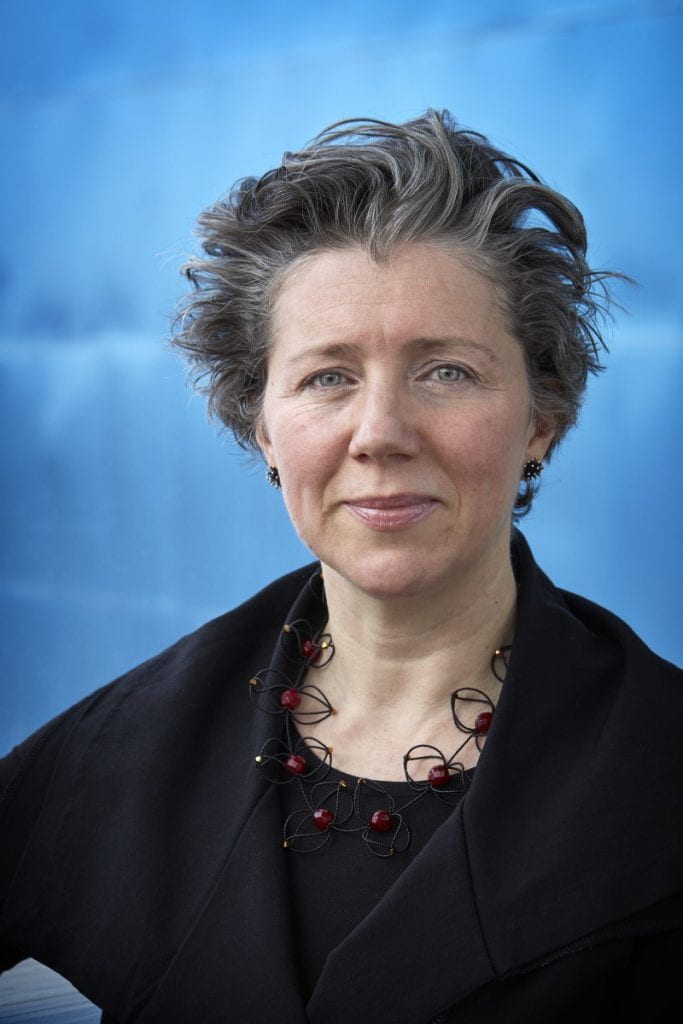
Georgiana Uhlyarik is the Fredrik S. Eaton Curator, Canadian Art, and co-lead of the Indigenous + Canadian Art Department at the Art Gallery of Ontario, Toronto. She co-curated: Tunirrusiangit: Kenojuak Ashevak and Tim Pitsiulak, the J.S. McLean Centre for Indigenous + Canadian Art, Introducing Suzy Lake, among several international collaborations. Originally from Romania, she lives in Toronto with her twin sons.
Image description: Georgiana faces the camera with short grey and brown wind-swept hair. She wears a black shawl and a string beaded necklace. The backdrop is a solid icy-blue.
Vanessa Dion Fletcher
The Language of Quillwork
Friday, January 21, 2022 from 1:00 PM – 1:45 PM
Vanessa Dion Fletcher introduces the audience to the art of quillwork and does an in-depth tour of how she uses this art form—presenting examples of her process, two-dimensional and performance. This presentation illuminates the space of language and communication from an anti ableist and decolonial perspective.
Related links:
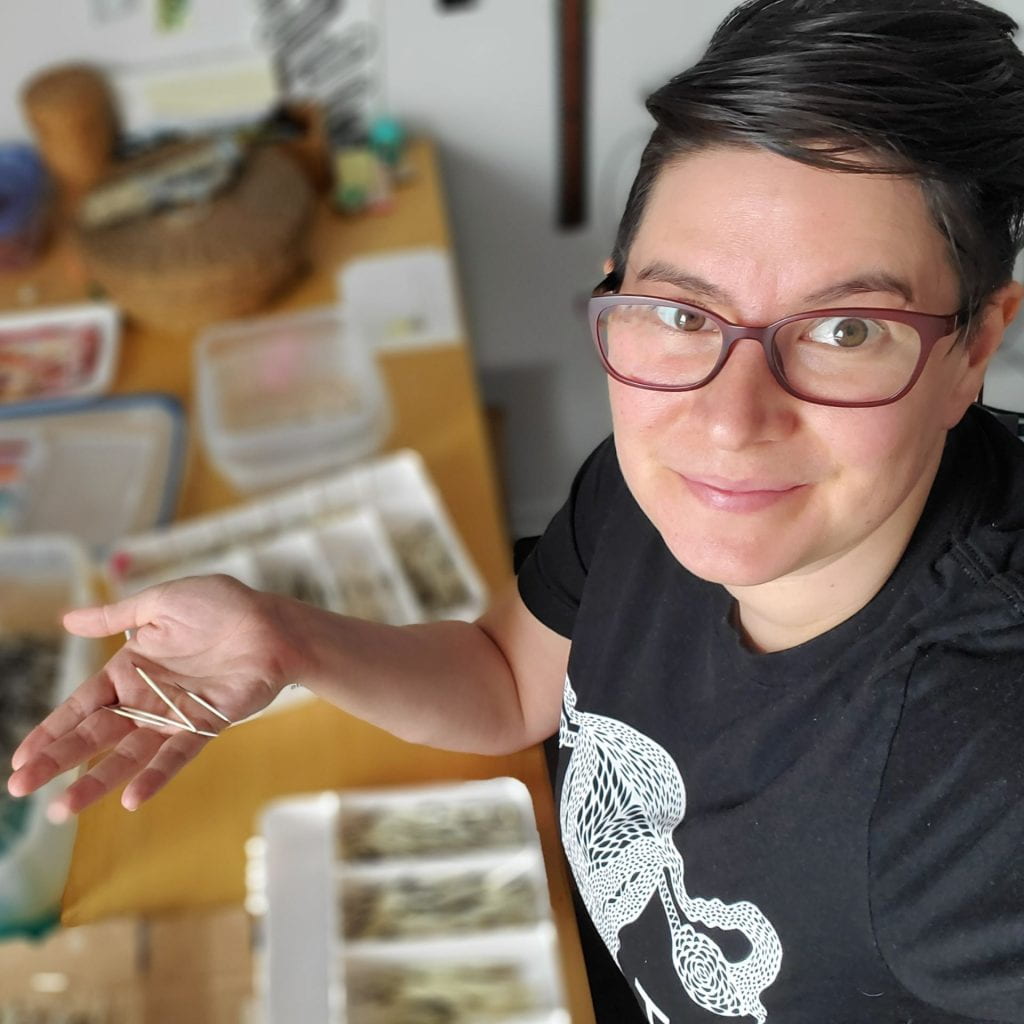
Vanessa Dion Fletcher is a Lenape and Potawatomi neurodiverse Artist. Her family is from Eelūnaapèewii Lahkèewiitt (displaced from Lenapehoking) and European settlers. She Employs porcupine quills, Wampum belts, and menstrual blood reveals the complexities of what defines a body physically and culturally. Reflecting on an indigenous and gendered body with a neurodiverse mind Dion Fletcher creates art using composite media, primarily working in performance, textiles and video.
Image description: Vanessa smiles at the camera while holding a handful of porcupine quills. She has short black hair, red glasses and a black t-shirt. There is a desk of materials in the background.
Site Menu
- Overview
- Event Activities
- Online Platforms
- Partners and Sponsors
- Programme At-A-Glance
- General Access Information
- Access Practices
- Gather Town – Access Guide
- Zoom – Access Guide
- Presenters, Performers, & Moderators – Access Guide
- Access Support Team
- Glossary of Terms
- Keynote Speakers
- Presenters
- Performers
- Restricted Access – Registered Attendees only



